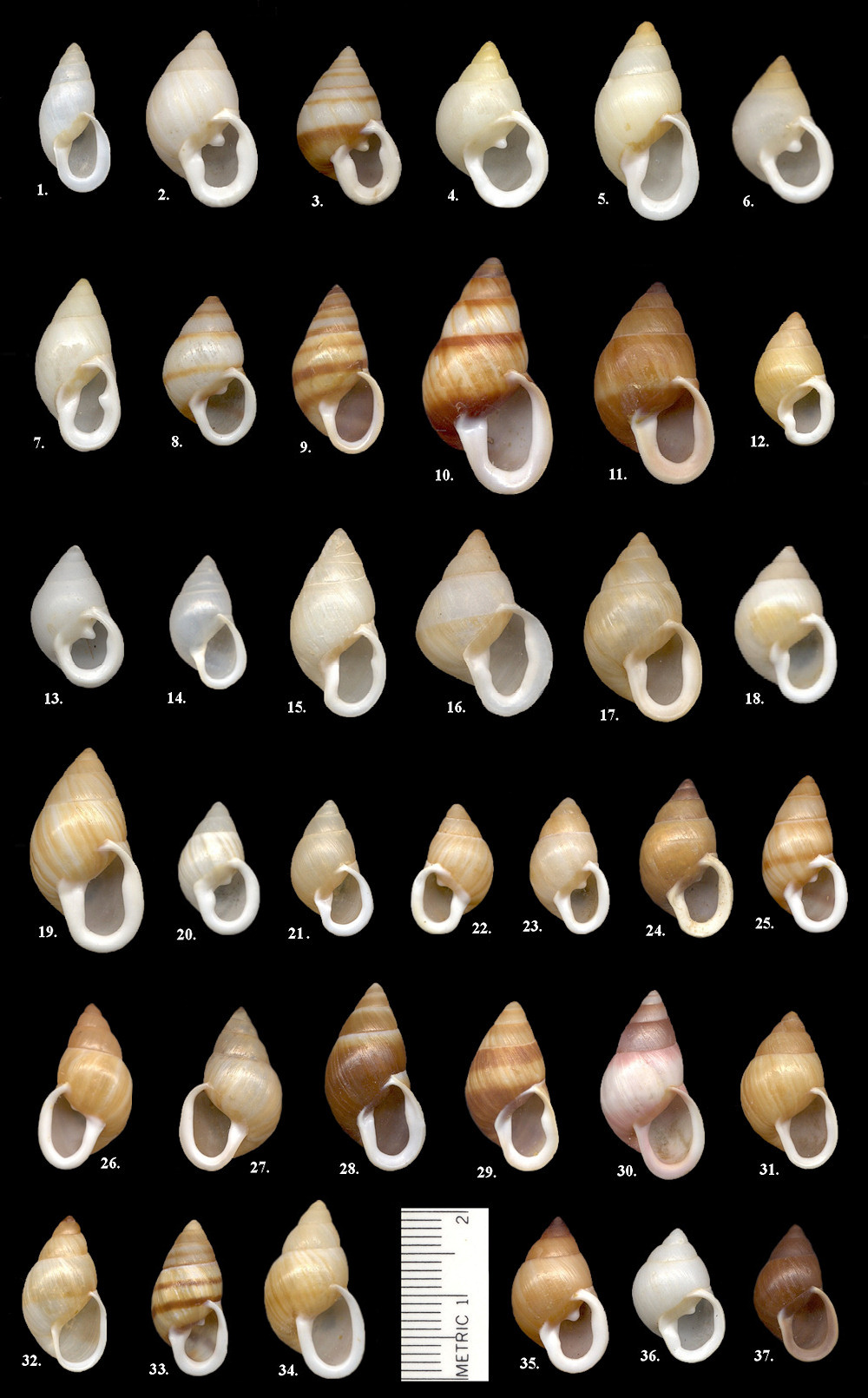 |
|
The family Partulidae Pilsbry, 1900 is deployed throughout the high
islands of south and western Oceania as well as New Guinea. Its
metropolis is in French Polynesia, particularly the Society Islands.
Here the nominotypical subgenus of Partula Férussac, 1819, with
over 50 species, is centered. Most P. (Partula) species are
limited to a single island even though several inter-island distances
are rather small. Although predominantly arboreal, there are several
terrestrial species. Of the four genera (eleven subgenera) in the
family, those of this subgenus distinguish themselves with a variety of
color patterns, more conspicuous in the tree-dwelling species. Most
islands have more than a single species, and ecological as well as
geographical forces seem to have driven their evolution. The steep
terrain isolates the many deep valleys, in which the snails prosper.
Besides allowing divergence of species, such topographic barriers have
allowed infraspecific variation (forms and subspecies) to evolve in taxa
distributed over relatively wide areas with varying landscape. Examples
of this include P. (P.) otaheitana (Bruguière,
1792)
[figs. 22-27
below] on Tahiti and P. (P.) rosea [figs. 31-32] on Huahine. |
 |
|
French Polynesian
Partulidae, principally the Society Islands.
Two genera, thirty-one ( 31) species, plus forms and subspecies arranged
alphabetically: locality by island.* Literature cited: [Gmelin, J.F.] Linné, C. a, 1791. Systema naturae 13th edition, volume 1, part 6: Vermes. Emanual Beer, Leipzig. Pp. 3021-3909. [Vermes testacea 3202-3748]. <http://www.biodiversitylibrary.org/item/83098#page/609/mode/1up>. Bruguière, J.G. [ed.] and C.H. Hwass, 1792. Encyclopédie méthodique. Histoire naturelle des vers. Tome première partie 2. Panckoucke, Paris. Pp. 345-757. 13 Feb. <http://www.biodiversitylibrary.org/item/35783#page/375/mode/1up>. ICZN, 1957. Opinion 479. Opinions of the International Commission for Zoological Nomenclature 16: 365-456. September 3. Martyn, T., 1784-87. The universal conchologist, exhibiting the figure of every known shell... drawn... and painted... with a new systematic arrangement, etc. 4 vols. Martyn, London. 27 pp., 161 pls. A French-English edition with all the 80 plates of the original volumes 1 and 2 (1784) is posted on-line at <http://lib.s.kaiyodai.ac.jp/library/digital/Martyn.htm> |
| Classic original figures of French Polynesian Partula species. |
 |
|
L to R: Limax faba from Thomas Martyn (1784: pl. 67, middle two figures, of four, edited just for juxtaposition), Partula inflata and P. rubescens from Lovell Augustus Reeve (1850: plate 1, fig 4a; plate 3, fig. 12 respectively), P. stenostoma and P. suturalis from Ludwig (Louis) Pfeiffer (1856: pl. 17, figs. 17, 18 respectively). |
|
Dall, W.H., 1906. Thomas Martyn and the Universal Conchologist. Proceedings of the United States National Museum 29: 415-432. Dall, W.H., 1908. Supplementary noted on Martyn's Universal Conchologist. Proceedings of the United States National Museum 33: 185-192. Johnson, R.I., 1969. Pfeiffer’s Novitates Conchologicae, Series I, Land Mollusca, 1854–1879, and Dunker’s Novitates Conchologicae, Series II, Marine Mollusca, 1862–1882. A complete collation. Journal of the Society for the Bibliography of Natural History 5(3): 236–239. October. Martyn, T., 1784-87. The universal conchologist, exhibiting the figure of every known shell... drawn... and painted... with a new systematic arrangement, etc. 4 vols. Martyn, London. 27 pp., 161 pls. [collation per Dall, 1906, 1908]. A French-English edition with all the 80 plates of the original volumes 1 and 2 (1784), and from which the above images are taken, is posted on-line at <http://lib.s.kaiyodai.ac.jp/library/digital/Martyn.htm> Pfeiffer L., 1854-1860. Novitates Conchologicae. Series Prima. Mollusca Extramarina Beschreibung und Abbildung neuer oder kritischer Land-und Süsswasser-Mollusken 1. Theodor Fischer, Cassel. 1-138 pp + pls. 1-36 [issued in twelve parts 1854 to May, 1860; [full collation by Johnson, 1969] Pilsbry, H.A., 1908-10. Manual of Conchology (second series). 20. Caecilioides, Glessula, Partulidae; index to volumes 16-20. Academy of Natural Sciences, Philadelphia. vii i+ 1-336 + 43 pls. Nov. 19 to Feb. Reeve, L.A., 1850 Monograph of the genus Partula. Conchologia Iconica 6: 9 pp, 4 pls. May. |
|
|